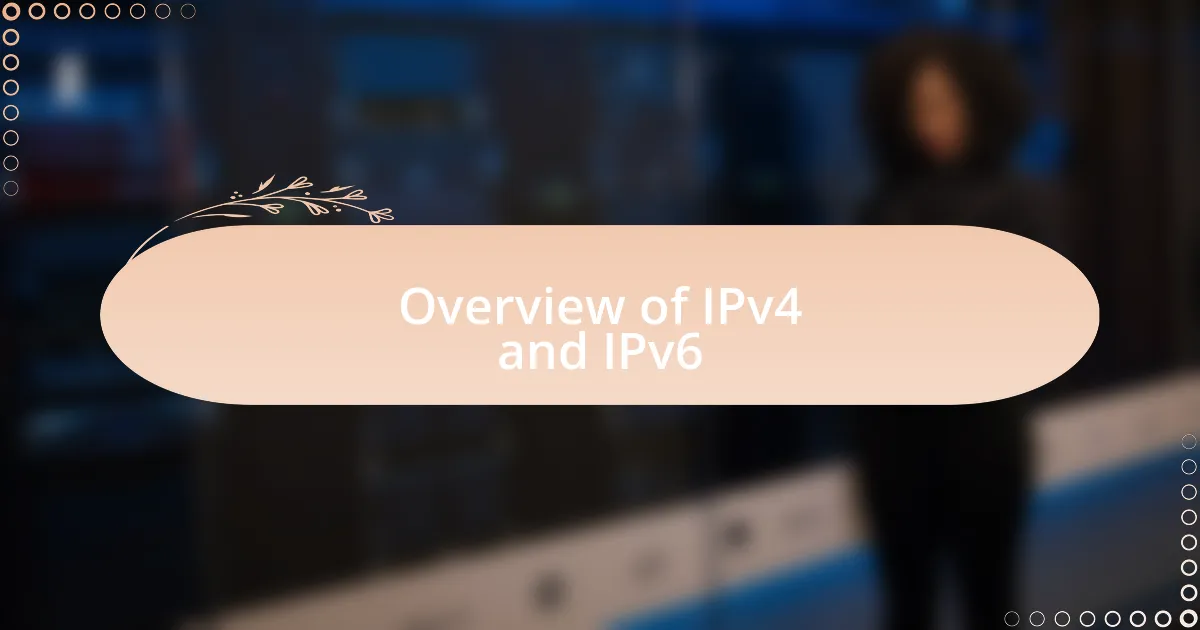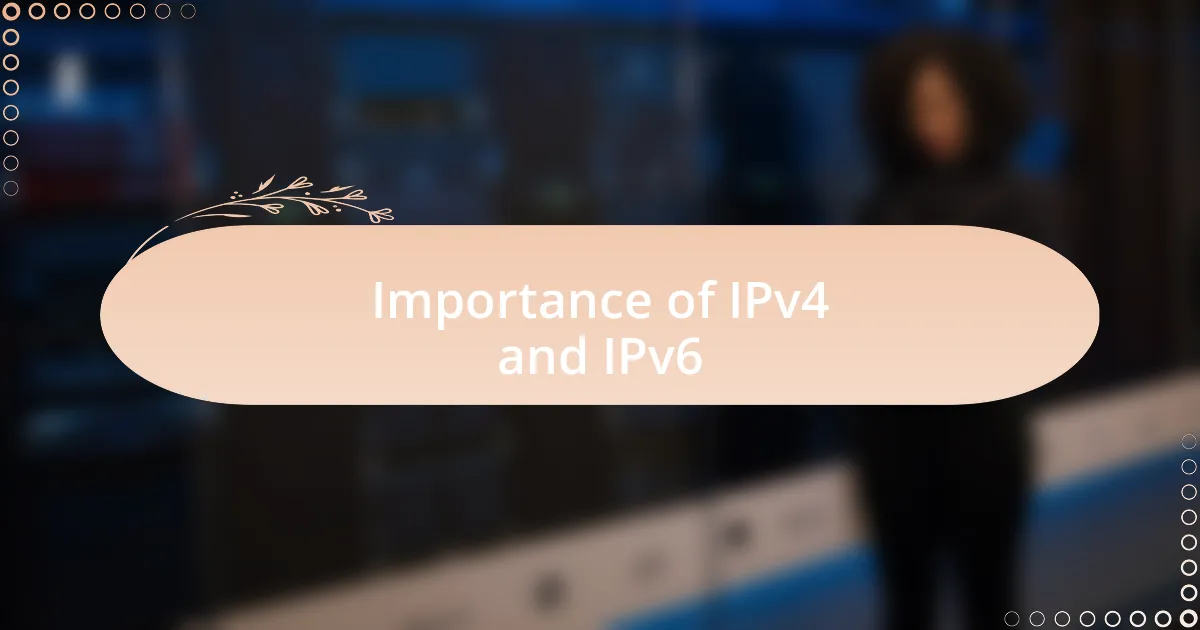Key takeaways:
- IPv4 provides limited address space, necessitating the shift to IPv6, which offers a vast 128-bit address space for modern internet needs.
- Transitioning from IPv4 to IPv6 poses challenges, including address conflicts and varying performance, requiring careful management of dual stack networks.
- IPv6 enhances internet security with built-in protocols, addressing vulnerabilities present in IPv4 systems.
- Effective IP address management tools, including IPAM solutions and CLI, are crucial for handling both IPv4 and IPv6 efficiently.

Overview of IPv4 and IPv6
IPv4, or Internet Protocol version 4, has been the backbone of internet communication for decades. With its 32-bit address space, it allows for approximately 4.3 billion unique addresses, which may seem like a lot until you realize how quickly we’ve consumed them. I still remember the excitement when I first learned about subnetting, a way to divide those addresses efficiently. But then reality hit—limited availability forced many of us to seek alternatives.
Enter IPv6, the next-generation protocol designed to replace IPv4. It boasts an almost unfathomable 128-bit address space, providing around 340 undecillion unique addresses. This shift to IPv6 not only alleviates address exhaustion concerns but also includes features like improved security and better routing efficiency. Reflecting on my own experience, I can’t help but feel a mix of apprehension and optimism about transitioning to this complex yet promising solution. Will we fully embrace IPv6, or will the inertia of IPv4 hold us back?
Navigating the coexistence of both IPv4 and IPv6 can feel like walking a tightrope. I’ve often wondered—how do we encourage businesses and individuals to make this leap? Many organizations hesitate, sticking with IPv4 because it’s familiar. Yet, the transition is crucial for sustainability in our ever-connected world. From my own journey working with clients, I’ve found that providing clear benefits and guidance can ease those fears and pave the way for a more robust internet foundation.

Importance of IPv4 and IPv6
The significance of IPv4 lies in its extensive usage and familiarity in the telecommunications realm. It’s astonishing to think about how many devices utilize this protocol daily. I can recall the frustration of running into conflicts while managing both IPv4 and IPv6 addresses during a large project. I needed to ensure seamless communication for everyone involved. In those moments, I truly appreciated how IPv4 provided a sense of stability, even as we navigated the complexities of transitioning to a newer technology.
On the other hand, IPv6 is not just a technical upgrade; it’s a necessity for the future of the internet. The sheer breadth of its address space offers us tremendous potential. I felt a wave of relief when I realized that IPv6 could support the explosion of IoT devices we are witnessing today. It’s like having the room to grow exponentially without the fear of running out of space. But I often wonder, how ready are we as a society to fully embrace this shift?
Beyond address allocation, the advancements in security features with IPv6 are particularly crucial in today’s cyber landscape. I remember a project where our team dealt with numerous security concerns with IPv4; implementing IPv6 felt like upgrading to a fortified fortress. The built-in security protocols in IPv6 gave me a sense of empowerment and confidence. Isn’t it reassuring to consider that this new protocol prioritizes not only connectivity but also our safety online?

Challenges of Dual Stack Networks
Managing dual stack networks brings with it a unique set of challenges that can test the resilience of any telecommunications professional. I recall grappling with address conflicts that arose when devices awkwardly transitioned between IPv4 and IPv6. It often felt like a delicate dance—ensuring systems worked in harmony while wading through the confusion that dual stack configurations might create.
One of the most surprising hurdles I encountered was the performance discrepancies between the two protocols. During a project, I noted that certain applications performed sluggishly on IPv6, even as their IPv4 counterparts whizzed along effortlessly. This inconsistency not only frustrated my team but also raised concerns about user experience; how could we assure clients of reliable service when our own infrastructure was dealing with such disparities?
Security emerged as another complex layer when navigating dual stack environments. I vividly remember a security audit that illuminated gaps in our IPv4 infrastructure, which had inadvertently remained unaddressed while we focused on IPv6 implementation. It got me thinking: in our eagerness to adopt new technologies, how often do we overlook the holes in our existing systems? Balancing old and new can be a formidable task, but it’s crucial for maintaining a secure and efficient network.

Tools for Managing IP Addresses
When it comes to managing IP addresses effectively, several tools stand out in my experience. I’ve relied on IP Address Management (IPAM) solutions that seamlessly integrate both IPv4 and IPv6 protocols. One particular IPAM tool I used provided a visual interface that made tracking allocations straightforward, allowing me to see potential conflicts at a glance. This not only simplified management but also saved me from some intense troubleshooting sessions.
I remember vividly how a network management software transformed our operations. It allowed us to automate routine tasks like IP address allocation and monitoring. The automation was a game-changer—it reduced human error significantly, which is crucial when you’re juggling two different protocols. Imagine being able to focus on strategic initiatives rather than getting bogged down by manual processes. Doesn’t that sound appealing?
Another tool that proved invaluable was the command-line interface (CLI) for quick diagnostics. It’s often easy to overlook the simplicity and power of CLI commands when managing IP addresses. One late night, I found myself using CLI to quickly check our routing configurations and verify that everything was in order. The instant feedback allowed me to pinpoint issues on the spot, reaffirming the importance of having versatile tools at my disposal. How often have you found that a simple diagnostic tool can save hours of frustration?